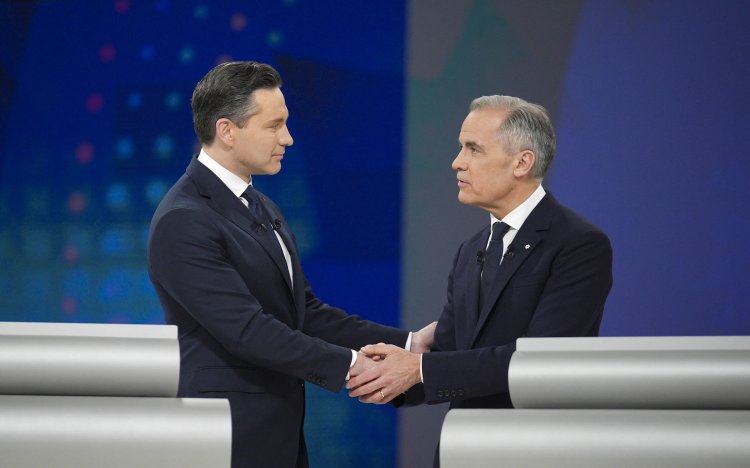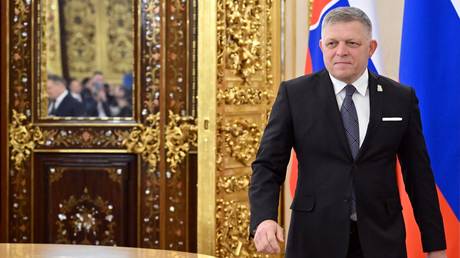Carney vs. Poilievre: As Canada Heads to the Polls, 'the shadow of Trump' Looms
A snap election characterized by economic concerns and threats of annexation has evolved into a competition between two candidates, each vying to demonstrate their ability to confront the president.

As advance polls opened on Friday, coinciding with a holiday weekend, Liberal Leader Mark Carney and Conservative Leader Pierre Poilievre are working to persuade undecided Canadians that they are equipped to confront the U.S. president.
During the final campaign debate held in Montreal on Thursday night, both leaders argued that Canada needs to showcase its resilience.
“We are facing the biggest crisis of our lifetimes. Donald Trump is trying to fundamentally change the world economy,” Carney stated. “What he's trying to do to Canada — he's trying to break us, so the U.S. can own us.”
With just 11 days remaining until Election Day, the race has reached a critical juncture, characterized by Oval Office turbulence, sharp insults, trade penalties, threats of annexation, and volatile markets. This unique context has effectively reconfigured a campaign that once featured five major parties into a two-person contest for the prime ministership.
It’s Carney versus Poilievre in this pivotal clash of Canada against Trump.
At enthusiastic rallies nationwide, Poilievre has aimed to draw Canadians’ attention to cost-of-living issues, attributing the affordability crisis to Carney’s party.
“The Liberal government has weakened our economy with anti-energy laws, red tape, and high taxes that have driven C$500 billion out of our country into the United States,” Poilievre asserted during the debate. “That weakness threatens our ability to stand up for ourselves.”
However, Poilievre’s team has faced scrutiny from analysts for not sufficiently confronting Trump directly.
As the short campaign approaches its finale, all candidates are straining for political survival, with what was once anticipated to be a Conservative sweep now looking more uncertain.
Poilievre has consistently portrayed Carney as “just like Justin,” blaming him for Liberal policies that purportedly led to a housing crisis and rising inflation. This tactic echoes Trump’s claims equating Kamala Harris with former President Joe Biden.
Carney, on the other hand, has taken deliberate steps to distinguish himself from Trudeau during his brief tenure as prime minister prior to calling the election. He has shifted the party’s position towards the center, eliminating Trudeau’s hallmark climate initiative — the consumer carbon price — on his first day in office. Additionally, he's collaborated with provinces to dismantle internal trade barriers, partnered with Australia on defense matters, and engaged the European Union regarding trade agreements aimed at fostering economic growth.
“We can give ourselves far more than Donald Trump can ever take away,” Carney has reiterated throughout the campaign.
Several pollsters have indicated that this election could see a significant voter turnout, alongside potential electoral challenges for the progressive New Democratic Party.
“This election shows Canada is moving toward a two-party system [federally],” Nik Nanos, chief research analyst for Nanos Research, remarked.
“We may be in a world where the two mainstream parties really dominate 8 out of 10 Canadian votes for either the Conservatives or the Liberals, and that will be very difficult for the Bloc Québécois and the Greens and NDP to be relevant.”
The declining fortunes of smaller parties have inadvertently benefited the Liberals, even as Poilievre seeks to expand Conservative voter support to levels reminiscent of former Prime Minister Stephen Harper's majority government in 2011.
With limited prospects, leaders of smaller parties battled for their political futures on the debate stage this week, while the Greens were excluded entirely.
“The Liberals have eaten [the NDP] vote, and at this point, it doesn’t look like it’s coming back,” stated Robert Martin, senior data analyst at Mainstreet Research.
NDP Leader Jagmeet Singh, whose party has collaborated closely with Trudeau to introduce publicly funded dental and pharmacare programs, has shifted his strategy from seeking a prime ministerial victory to convincing voters that his party will safeguard social programs in the House of Commons.
“I'm asking for your support in this election so that I can continue to fight to defend the things that make us Canada, the things that we hold dear, the things that make us proud to be Canadians,” Singh declared during the debate.
In a similar vein, Bloc Québécois Leader Yves-François Blanchet aims to demonstrate that he is the only leader capable of defending the language, culture, values, and immigration policies relevant to his province.
Advance polls, which opened on Good Friday, will close on Easter Monday, providing campaigns with insight into voter turnout ahead of Election Day on April 28.
Ontario Premier Doug Ford recently showcased an effective counter-campaign against Trump, winning his third consecutive landslide in February, arguing that a new mandate was necessary to confront a trade war.
“Donald Trump thinks he can break us,” Ford stated in his victory speech. “He is underestimating the resilience of the Canadian people, the Canadian spirit. Make no mistake, Canada won’t start a fight with the U.S., but you better believe we’re ready to win one.”
Carney has since built upon Ford’s successful rhetoric, adopting it as his own campaign slogan: “Trump’s strategy is to break us so America can own us.”
The fear of Trump remains palpable in a province where Ford has warned that tariffs pose a threat to 500,000 jobs.
“Canada is not for sale,” Ford asserted in a recent address that marked the opening of a new session in the Ontario legislature. “Canada will never be the 51st state.”
While Trump’s talk of annexation had quieted temporarily, White House press secretary Karoline Leavitt stated this week that it was merely due to a lack of media inquiries on the subject. “He believes Canadians would benefit greatly from becoming the 51st state,” she confirmed.
The U.S. president has vowed to “permanently shut down” car manufacturing in Canada, recently imposing 25 percent tariffs on all automobile imports to the United States, with a few exceptions under the United States-Mexico-Canada Agreement. Earlier this month, Stellantis cited U.S. tariffs as justification for temporarily halting production at its Windsor, Ontario assembly plant.
The latest projections from the poll tracker 338Canada indicate that Carney’s Liberals could secure up to 93 of Ontario’s 122 federal districts. A path to a majority federal government requires the Liberals to sweep numerous seats in Ontario, particularly in the populous areas of Toronto and its suburbs.
Back in December, a survey from Abacus Data revealed “the largest Conservative lead in our tracking history and the lowest Liberal vote share since 2015.” Pressure had been mounting on Trudeau’s caucus to compel the three-term prime minister to step down, though it was ultimately the dramatic resignation of then-Deputy Prime Minister Chrystia Freeland that catalyzed action on his part.
In her resignation letter, Freeland cautioned: “How we deal with the threat our country currently faces will define us for a generation, and perhaps longer.”
Both Carney and Poilievre have expressed their eagerness to engage with Trump once the election concludes.
“On my first day as prime minister, I will restart negotiations to accelerate a deal that will put an end to the tariffs and protect our sovereignty,” Poilievre stated in Wednesday’s French debate.
Earlier in the campaign, Carney took a brief hiatus from campaigning to address Trump directly on Parliament Hill. “The old relationship we had with the United States, based on deepening integration of our economies and tight security and military cooperation, is over,” he noted.
Clearly, Carney is seeking more than just a return to prior relations.
“It’s clear the U.S. is no longer a reliable partner,” he emphasized. “There will be no going backwards.”
Sanya Singh for TROIB News
Find more stories on Business, Economy and Finance in TROIB business











